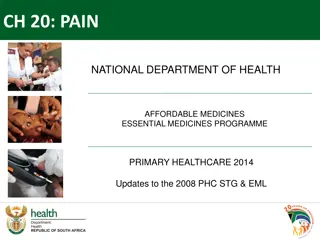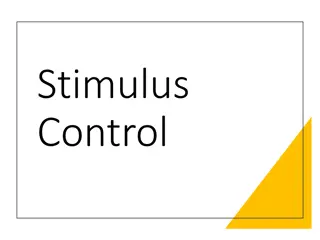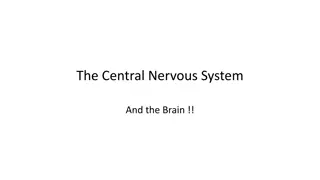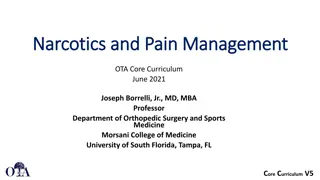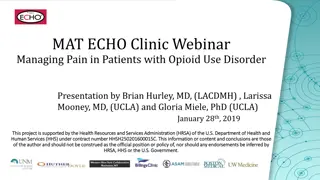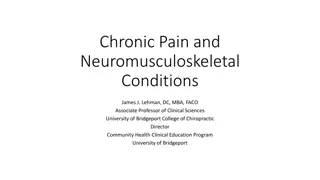Interpersonal factors and their impact on pain transitions
Exploring the impact of interpersonal factors on pain transitions, this research delves into the communication and behaviors between individuals experiencing pain, such as parent-child relationships and interactions with healthcare providers. The study analyzes psychosocial mechanisms influencing pa
3 views • 24 slides
Acute orofacial pain
Acute orofacial pain is often associated with dental issues, ranging from dentinal pain to periodontal pain. The pain can be moderate to severe, with various triggers such as mechanical stimulation and changes in osmotic pressure. This pain is prevalent in adults and can spread to different areas of
1 views • 49 slides
Understanding Breast Pain and the Breast Pain Pathway
Breast pain, characterized by tenderness, throbbing, sharp, or burning sensations in the breast tissue, can affect individuals of all genders. This common symptom may vary in severity and frequency, and is typically not associated with cancer. The Breast Pain Pathway outlines the management of breas
2 views • 13 slides
Understanding Sickle Cell Disease Pain Management
Sickle cell disease (SCD) patients often experience vaso-occlusive crises (VOC) causing acute pain, a hallmark symptom of the disease. Pain management is crucial in healthcare interactions for these patients, with chronic pain also being a significant concern due to organ/tissue damage. Research sho
1 views • 18 slides
Common Role of Pain Management for Chronic Back Pain
Discover how CT Clinic Presents is revolutionizing the approach to chronic back pain treatment through a comprehensive Pain Management program. We prioritize patient education, offering insights into the condition and its management. Our holistic approach integrates medication management, physiother
1 views • 1 slides
Assessment and Diagnostic Tests in Musculoskeletal System Pain
Pain in musculoskeletal conditions varies, such as bone pain described as dull and deep, muscular pain as soreness, fracture pain as sharp, and joint pain worsens with movement. Specific assessments by nurses include checking body alignment, joint symmetry, signs of inflammation, pressure sources, a
7 views • 38 slides
Do you want relief from Neck Pain in South Brisbane
Do you want relief from Neck Pain in South Brisbane? Then contact Innervate Chiro. Their dedicated practitioners combine their experience in Chiropractic, Remedial & Sports Massage for fast effective relief of Back Pain, Neck Pain, Headaches, Vertigo, Sports Injuries, shoulder, hip, nerve pain, scia
0 views • 6 slides
Get the best physiotherapy for Back Pain in Orchard
Get the best physiotherapy for Back Pain in Orchard at Physiolife Pte Ltd. Their experienced therapists provide hands-on therapy and evidence-based practice to individuals seeking personalized treatment for their pain and injuries. They specialize in technology-powered solutions like medical massage
2 views • 6 slides
Complex Case Study: Chronic Pain and Somatic Symptom Disorder
Michelle Adams, a 51-year-old hairdresser, presents with severe chronic back pain following a traumatic incident. Despite various treatments and medications, her pain persists, leading to distress and functional impairment. Her symptoms align with Somatic Symptom Disorder (SSD) with predominant pain
0 views • 50 slides
Understanding Opioid and Non-Opioid Analgesics in Pain Management
Opioid analgesics, such as morphine, act in the central nervous system to relieve pain without affecting consciousness. They differ from non-opioid analgesics like aspirin in terms of CNS depression, pain type targeted, and addiction potential. Pain is a protective mechanism caused by tissue damage
0 views • 25 slides
Understanding Central Abdominal Pain and Masses in Clinical Practice
Abdominal pain evaluation involves considering various differential diagnoses such as appendicitis, small bowel obstruction, and mesenteric ischemia. By categorizing pain as visceral, parietal, referred, or radiating, healthcare providers can better understand the underlying pathology. The history o
0 views • 57 slides
Understanding the Gate Control Theory of Pain in Pain Management
This detailed content delves into the Gate Control Theory of Pain, explaining pain pathways involving nociceptors, A-delta fibers, and C fibers. It further explores central pain pathways like the spinothalamic tract, spinomesencephalic tract, and spinoreticular tract. The theory's mechanism of pain
3 views • 11 slides
Complexity in Cancer Pain Management by Dr. Marie Joseph
Dr. Marie Joseph explores the challenges and successes of managing complex pain in cancer patients. The intricacies of neuropathic pain, diagnostic characteristics, pathophysiology, pharmacology, and typical cancer pain syndromes are discussed. Strategies such as co-analgesic adjuvants, analgesic sy
0 views • 12 slides
Understanding Sensation and Perception in Psychology
Sensation and perception play crucial roles in how we experience the world around us. Sensation involves the detection of stimuli through sensory organs, while perception involves the interpretation of these stimuli in the brain. The process includes transduction, where physical energy is converted
1 views • 19 slides
Understanding Sensation and Perception in Psychology
Explore the fascinating world of sensation and perception in psychology, where we delve into how our senses interact with stimuli to create our conscious experiences. Sensation involves the activation of our sense organs by external stimuli, while perception refers to the interpretation of those sti
3 views • 19 slides
Update on Pain Management in Primary Healthcare
The updates to the 2014 Primary Healthcare Implementation Slides focus on pain control for children, including the addition of ibuprofen and exclusion of tramadol for moderate pain. The management of acute severe pain involves retaining morphine injection while omitting metocloperamide, paracetamol,
0 views • 10 slides
Understanding Pediatric Pain Management
Explore the complexities of managing pain in infants and children, including defining pain, classifying different types of pain, understanding pain assessment tools, identifying medication classes for treatment, and recognizing special considerations. Discover insights on acute and chronic pain, neu
1 views • 40 slides
Understanding the Brain: Key Insights on Chronic Pain and EMDR Therapy
Persistent pain is often a symptom originating from the brain, not the body tissues. EMDR therapy can help reprocess maladaptive memory networks linked to chronic pain, addressing root causes including adverse childhood experiences. The AIP model emphasizes early-life factors in shaping chronic pain
0 views • 28 slides
Understanding the McKenzie Method for Pain Management
The McKenzie Method, developed by physiotherapist Robin McKenzie, is a classification-based system for treating pain. It involves assessment, treatment, and prevention steps, with an emphasis on centralizing symptoms and promoting pain reduction. The method categorizes pain into three syndromes - Po
2 views • 23 slides
Understanding Stimulus Control in Behavior
Stimulus control refers to the influence of stimuli on behavior. When a behavior is under stimulus control, it occurs in the presence of certain stimuli and not in their absence. This concept is crucial in understanding how behaviors are triggered and maintained based on the presence or absence of s
2 views • 56 slides
Exploring the Intersection of Chronic Pain and BDSM in Critical Disability Studies
Critical Disability Studies examines power dynamics in bodily and mental norms, including the experiences of chronic pain within BDSM and erotic play. Research delves into discourses of pain, challenging assumptions and stigma associated with chronic pain and disability. The study emphasizes collabo
0 views • 9 slides
Understanding Pain Assessment: Factors, Tools, and Relief
Pain assessment is crucial for understanding and managing patients' pain perception. This involves identifying different forms of pain, factors affecting pain sensitivity, behavioral responses to pain, and utilizing pain assessment tools for accurate evaluation. Factors influencing pain sensitivity
0 views • 18 slides
Understanding Pain: Mechanisms and Pathways
This content delves into the intricate mechanisms of pain perception, exploring the anterolateral system, nociceptors, endogenous analgesic systems, and more. It covers topics such as free nerve endings, VR1/Capsaicin receptors, referred pain, neuropathic pain, hyperalgesia, and visceral pain. The m
0 views • 15 slides
Understanding Pain and Analgesics in Medical Science
Pain is a complex sensory and emotional experience linked to tissue damage, with various types of nerve fibers and nociceptors playing key roles in its perception. Pain mediators like bradykinin and prostaglandins modulate sensitivity to pain stimuli. Analgesics, including non-opioid NSAIDs and opio
0 views • 23 slides
Understanding the Nervous System and Sensory Neurons
The nervous system plays a crucial role in connecting the central nervous system (CNS) to limbs and organs through the peripheral nervous system (PNS). It consists of sensory neurons that transmit impulses from sensory receptors to the CNS, allowing us to perceive and respond to various stimuli. The
0 views • 23 slides
Understanding the Central Nervous System and Brain
The central nervous system plays a crucial role in enabling organisms to respond to stimuli and adapt to changes in the environment. Comprising receptors, neurones, and effectors, this system facilitates the detection of stimuli, transmission of messages, and appropriate responses. Neurones, includi
0 views • 18 slides
The Use of Music and Auditory Stimuli in Psychological Therapy with Extreme Abuse Survivors
Extreme abuse survivors often find solace and emotional regulation through music and other auditory stimuli, which can evoke various responses such as containment, identity switching, and flashbacks. Despite being less discussed in clinical literature, these stimuli play a crucial role in therapy wi
0 views • 27 slides
Integrative Approaches to Pediatric Pain Management: A Comprehensive Review
Pediatric pain management is a complex issue involving factors such as inflammation, neuroplasticity, and emotional responses. Dr. Matthew Hand explores integrative approaches to address common pediatric pain conditions and highlights the prevalence of chronic pain in children. The presentation delv
0 views • 39 slides
Understanding the Science of Pain and Neural Integration
Pain is a complex sensory and emotional experience linked to tissue damage. It serves as a warning, aids learning, and triggers responses like rest. Key terms include noxious stimuli, nociceptors, pain threshold, and pain tolerance. Neural pathways transmit sensory and motor information, involving a
0 views • 80 slides
Understanding Pain Management in Orthopedic Surgery
Pain management in orthopedic surgery involves reviewing pain pathways, mitigating pain transmission, understanding pain medications, and implementing multi-modal pain relief strategies. Pain is a complex and subjective experience with sensory, affective, emotional, and cognitive dimensions. Factors
0 views • 51 slides
Understanding Postoperative Pain Measurement Methods
Standard methods for measuring postoperative pain include categorical, visual analogue, and numerical rating scales. Patients should self-assess their pain using these tools for accurate reporting, as demonstrated by research on pain congruence between patients and nurses. Enhancing understanding of
0 views • 16 slides
Understanding Non-Opioid Pain Management Strategies
Non-opioid pain management is crucial in the current opioid epidemic, requiring physicians to navigate chronic pain without relying on opioids. This comprehensive approach involves a deep understanding of non-opioid analgesic medications, the nature of pain, anatomy, and physiology of nociception, t
0 views • 36 slides
Understanding Pain Management: Acute vs. Chronic Pain and Interventional Therapies
Pain is a complex experience that can be acute or chronic, requiring different treatment approaches. Acute pain alerts us to potential injury, while chronic pain lasts longer and affects quality of life. Management options range from medical and psychological treatments to advanced interventions and
0 views • 26 slides
Cost Savings in Postoperative Pain Management with NOL-Guided Anesthesia
Acute postoperative pain is a significant issue globally, with high prevalence rates and potential long-term consequences. This economic assessment explores cost savings associated with using NOL-guided anesthesia to optimize postoperative pain treatment. By categorizing postoperative pain scores an
0 views • 4 slides
Understanding Chronic Pain, Opioids, and Addiction in Medicine
Chronic pain is a complex issue that can impact individuals on various levels. It is important to understand the subjective nature of pain and the barriers to adequate pain care. Opioid analgesics, while effective in managing pain, come with risks such as side effects, addiction, and overdose potent
0 views • 28 slides
Managing Pain in Patients with Opioid Use Disorder: Strategies and Approaches
This presentation discusses essential factors to consider when treating pain in patients with Substance Use Disorder (SUD), including approaches for acute pain in those on Medication-Assisted Treatment (MAT) and non-opioid therapies for chronic pain. The information covers altered pain experiences i
0 views • 26 slides
Understanding Chronic Pain: A Comprehensive Overview
Chronic pain and neuromusculoskeletal conditions are prevalent health issues that require a specialized approach for accurate diagnosis and treatment. This content delves into learning objectives, national pain strategies, and the significance of addressing persistent pain as a chronic illness that
0 views • 80 slides
Understanding Biological Responses: Homeostasis, Stimuli, and Feedback Mechanisms
Explore the concepts of homeostasis, stimuli, and feedback mechanisms in biological systems. Learn how organisms maintain internal balance, respond to internal and external stimuli, and regulate bodily functions through feedback processes. Discover examples of responses such as sweating when hot, sq
0 views • 10 slides
Understanding the Three-Stage Process of Perception
Perception is a complex three-stage process that involves translating raw stimuli into meaning. This process includes sensation, where sensory receptors respond to stimuli, and perception, where sensations are organized and interpreted. Marketers leverage sensory cues such as colors, sounds, and odo
0 views • 8 slides
Comprehensive Overview of Pharmacological Pain Management Strategies
This comprehensive overview covers various aspects of pharmacological pain management, including behavioral measures for patients unable to self-report pain, building pain regimens, NSAIDs use and associated risks, NSAIDs and COX selectivity, clinical presentation of pain symptoms, gabapentinoids fo
0 views • 22 slides















